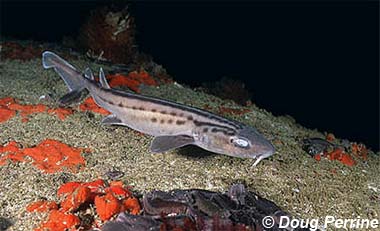
Poroderma pantherinum
This nocturnal catshark is found in the warmer coastal waters off of southern Africa, usually sleeping among the rocky reefs during the day and hunting crustaceans and small body fish at night.
Order – Orectolobiformes
Family – Scyliorhinidae
Genus – Poroderma
Species – pantherinum
Common Names
- English: Leopard catshark, Barbeled catshark, Blackspotted catshark
- Afrikaans: Luiperd-kathaai, Swartkol-kathaai
- Danish: Leopardrødhaj, Skægget rødhaj
- Dutch: Panterkathaai
- French: Roussette barbichette, Roussette panthère
- Spanish: Alitán de barbilla, Alitán leopardo
Importance to Humans
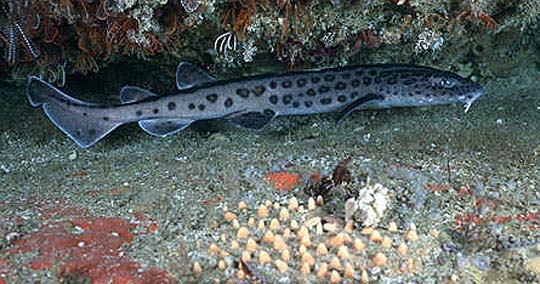
Although the leopard catshark is of no importance to commercial fisheries, it is commonly taken by bottom trawlers as well as by shore and boat anglers. This species is often displayed at public aquaria due to its striking coloration as well as its adaptability to living in captivity. (Compagno 1984)
Danger to Humans
Due to its small size and feeding habits, it is considered harmless to humans.
Conservation
The leopard catshark is listed as data insufficient with the World Conservation Union (IUCN). The IUCN is a global union of states, governmental agencies, and non-governmental organizations in a partnership that assesses the conservation status of species.
> Check the status of the leopard catshark at the IUCN website.
Geographical Distribution
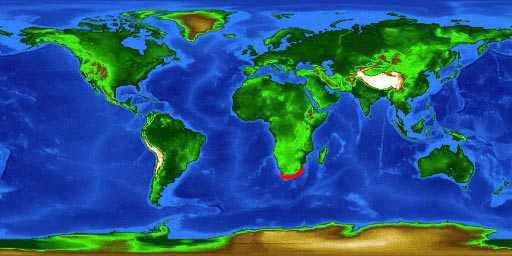
The leopard catshark is endemic to the southeastern Atlantic Ocean off the coast of Saldanaha to central Natal, South Africa.
Habitat
Living near or on the bottom substrate within warm temperate waters, the leopard catshark prefers rocky reef habitats from the intertidal zone to depths of 256m (840 feet). It is a nocturnal shark, meaning it is most active during the night-time hours. (Compagno et. al 1989)
Biology
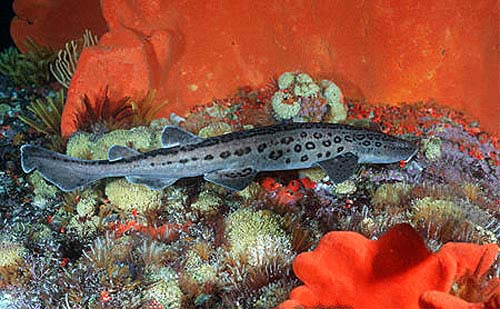
Distinctive Features
This shark has a stocky and compressed body, tapering considerably to the caudal fin. The barbels of the anterior nasal flaps are quite long, usually reaching the mouth. The dorsal fins are positioned posteriorly, the second dorsal fin is much smaller than the first dorsal fin. The origin of the anal fin is well behind the pelvic fin bases; the caudal fin is short and broad. (Compagno et. al 1989)
Coloration
The most striking thing about this shark is its leopard-like coloration which gives rise to its common name. The highly variable coloration pattern consists of black spots, rings, and lines arranged in horizontal rows on a grey to pale background. The ventral surface of the leopard shark is white.
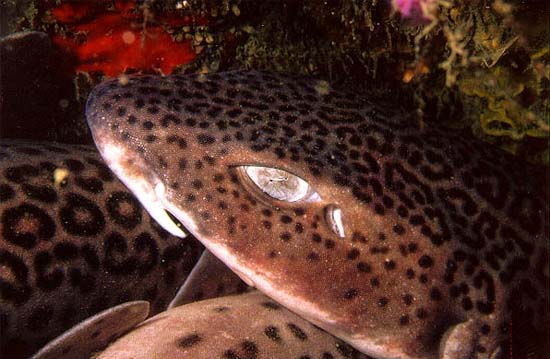
Three different color morphs exist within this species. The typical “panterinium” coloration consists of lines and rings of spots. In contrast, the two extreme coloration forms consist of the “marleyi” coloration that has large dark spots and was at one time considered an entirely separate species; and the “salt and pepper” coloration that has densely spaced black spots. In addition, intermediates between these two extreme coloration patterns are very common. (Compagno et. al 1989)
Denticles
The denticles of the leopard shark are well calcified.
Size, Age & Growth
The maximum reported length for a male leopard catshark is 84.9 cm (33.4 inches) total length (TL); the maximum reported length for a female of this species is 73.0 cm (28.7 inches) TL. Males reach sexual maturity at lengths of 54-59 cm (21.3-23.2 inches) while females mature at lengths of 58-61 cm (22.8-24.0 inches). (Compagno 1984)
Food Habits
The leopard catshark feeds on small bony fishes, crustaceans, octopi, and polychaete worms. (Compagno et. al 1989)
Reproduction
As an oviparous species, females release egg cases that contain embryos into the environment. The embryo continues to develop until it hatches from the egg case and becomes a free-swimming juvenile(Compagno et. al 1989).
Predators
The sevengill shark, Notorynchus cepedianus, is a documented predator of the leopard catshark (Ebert 1991). Other potential predators include large fish such as sharks as well as marine mammals.
Parasites
Parasites of the leopard catshark include larval copepods (Gnathia pantherina sp. n.) collected from the gills, nares, and bucchal cavity of a single specimen.
Taxonomy
The leopard catshark was originally described and named Scyllium pantherium by Müller & Henle in 1838. This name was later changed to the currently valid Poroderma pantherinum (Müller & Henle 1838). Synonyms include Scyllium variegatum Müller & Henle 1838, Scyllium maeandrinum Müller & Henle 1838, Poroderma variegatum Müller & Henle 1838, Poroderma submaculatum Smith 1838, and Poroderma marleyi Fowler 1934.
Revised by: Tyler Bowling and Nava Kiss 2019
Prepared by: Cathleen Bester
References
- Compagno, L.J., 1984. Sharks of the world: an annotated and illustrated catalogue of shark species known to date (No. QL 638.9. C65).
- Compagno, L.J.V., D.A. Ebert and M.J. Smale, 1989. Guide to the sharks and rays of southern Africa. New Holland (Publ.) Ltd., London. 158 p.
- Ebert, D.A., 1991. Observations on the predatory behaviour of the sevengill shark Notorynchus cepedianus. South African Journal of Marine Science, 11(1), pp.455-465.
- Yeld, E.M., 2009. Parasite assemblages of three endemic catshark species from the west and south coasts of South Africa.